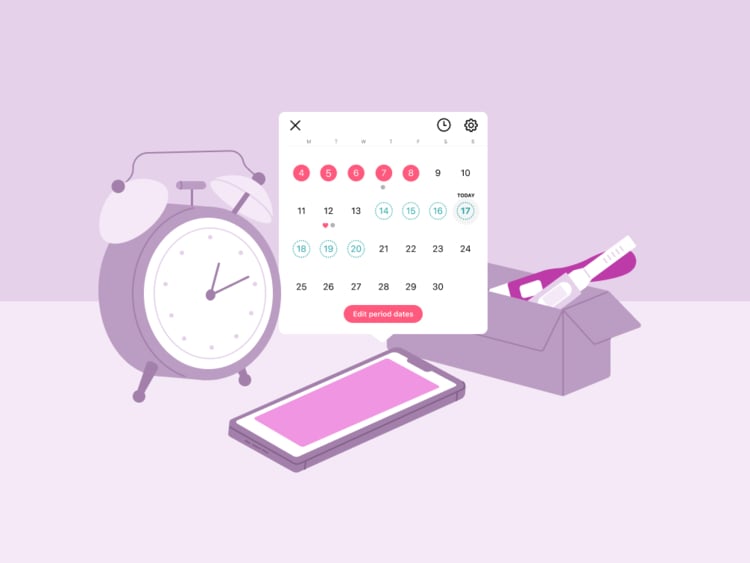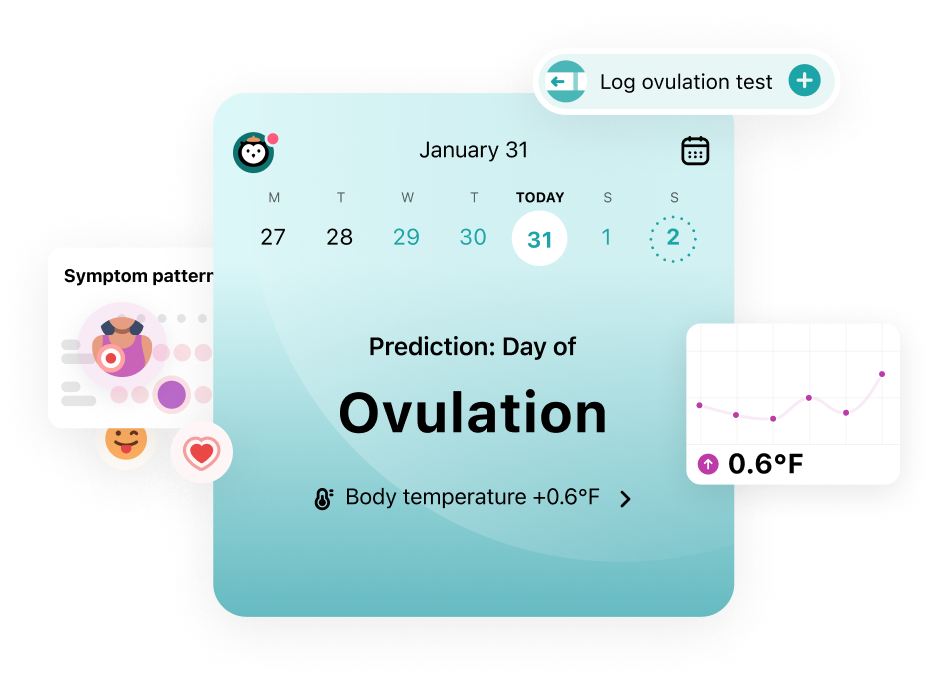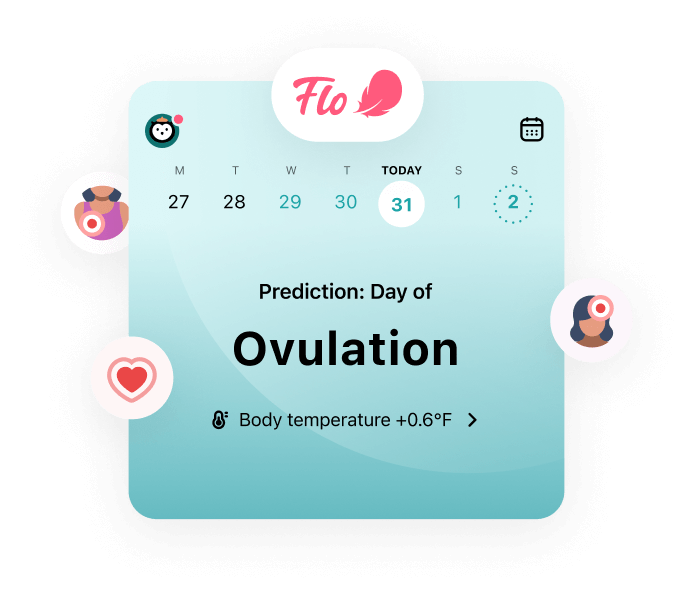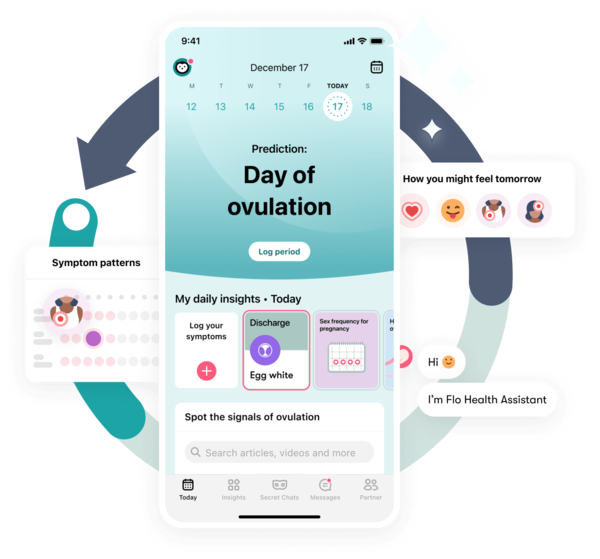Find out when ovulation happens, how it might make you feel, and when your fertile window might be.
-
Tracking cycle
-
Getting pregnant
-
Pregnancy
-
Help Center
-
Flo for Partners
-
Anonymous Mode
-
Flo app reviews
-
Flo Premium New
-
Secret Chats New
-
Symptom Checker New
-
Your cycle
-
Health 360°
-
Getting pregnant
-
Pregnancy
-
Being a mom
-
LGBTQ+
-
Quizzes
-
Ovulation calculator
-
hCG calculator
-
Pregnancy test calculator
-
Menstrual cycle calculator
-
Period calculator
-
Implantation calculator
-
Pregnancy weeks to months calculator
-
Pregnancy due date calculator
-
IVF and FET due date calculator
-
Due date calculator by ultrasound
-
Medical Affairs
-
Science & Research
-
Pass It On Project New
-
Privacy Portal
-
Press Center
-
Flo Accuracy
-
Careers
-
Contact Us
When is ovulation? Here’s how to figure it out


Every piece of content at Flo Health adheres to the highest editorial standards for language, style, and medical accuracy. To learn what we do to deliver the best health and lifestyle insights to you, check out our content review principles.
Ovulation is the point in your cycle when one of your ovaries releases an egg. But there’s a bit more to it than that.
If you’re currently trying for a baby, then it’s the big moment in your cycle to know about because it signals your fertile window (aka when to have conception sex).
And, even if you’re not thinking about pregnancy, understanding when you’re ovulating can help you understand your body better. You’ll ovulate around 400 times in your life, so being able to spot the signs and symptoms may also explain why you feel certain ways at different points in your cycle.
So, here’s the lowdown on all things ovulation, including how to figure out when it’s happening and how long it might last.
Key takeaways
- Ovulation is the part of your menstrual cycle when one of your ovaries releases a mature egg.
- The egg is viable for 12 to 24 hours after it’s been released, which means if you have unprotected sex during this time, it may be fertilized by a sperm, and you might get pregnant.
- The timing of ovulation varies from person to person. It can also change throughout your lifetime. But knowing roughly when it is for you can help you understand any cycle symptoms better and get pregnant.
- There are lots of different ways you can track when you’re ovulating, including using a cycle-tracking app like Flo.
- Some people experience signs and symptoms around the midpoint of their cycle. This could be your body indicating to you that you’re ovulating.
- If you’re already a pro at tracking your cycle, then you may notice that sometimes you ovulate on different dates or ovulation is late one cycle. This is really common

 Over
7.8M
ratings averaging
4.8/5
*
Over
7.8M
ratings averaging
4.8/5
*
Understand your fertility better with the Flo app
- Learn more about your fertility signals
- Improve ovulation predictions by tracking temperature via Apple Watch
- Log your ovulation test results
 Over
7.8M
ratings averaging
4.8/5
*
Over
7.8M
ratings averaging
4.8/5
*

Trying to conceive?
The Flo app can help you better understand your fertility

 Over
7.8M
ratings averaging
4.8/5
*
Over
7.8M
ratings averaging
4.8/5
*
Understand your fertility better with the Flo app
- Learn more about your fertility signals
- Improve ovulation predictions by tracking temperature via Apple Watch
- Log your ovulation test results
What is ovulation, and when does it happen?
Before we dig into when you might ovulate, here’s what it actually means. Ovulation is the point in your menstrual cycle when one of your ovaries releases an egg. After it leaves your ovary, the egg moves down one of your uterine (or fallopian) tubes. It can remain there for 12 to 24 hours. If you have unprotected sex during this time, then a sperm may fertilize it, and you might become pregnant. If this doesn’t happen, then it will disintegrate.
While it can differ from person to person and throughout your lifetime, ovulation generally occurs midway through your menstrual cycle. You may release an egg in between your follicular phase which starts on the first day of your period and sees your ovary prepare the egg for release, and the luteal phase. During your follicular phase (just before ovulation), your estrogen levels rise, helping the lining of your uterus to grow and thicken. This creates the perfect environment for your egg to implant should it be fertilized by a sperm after you’ve ovulated.
So, if you have an average cycle of 28 days, you will ovulate around day 14. In reality, we all have slightly different cycle lengths — meaning the exact day of ovulation varies. Just know that if your cycle is between 21 and 35 days long, then it’s considered typical, and ovulation will usually happen 14 days before your next period.
Take a quiz
Find out what you can do with our Health Assistant

How do I know when ovulation is for me?
“First up, I always recommend my patients use an ovulation-tracking app like Flo, where you’re monitoring your cycle every month,” says Dr. Sara Twogood, obstetrician and gynecologist, Cedars-Sinai Medical Group, California, US. Flo uses your personal cycle data to predict your most fertile days, plus your specific day of ovulation, each month. Neat, huh?
“But no method is 100% accurate,” Dr. Twogood continues, “So, for people who want to feel as confident as they can — that is, people who are trying to get pregnant — I recommend using multiple ways to track ovulation at once.”
“For a second method, it’s about whatever makes the most sense for you. It could be ovulation predictor kits, which are at-home tests that check your urine. Or it could be monitoring your cervical mucus or basal body temperature (BBT).” More on these methods below.
What signs and symptoms of ovulation should you look for?
There are certain bodily changes you may notice when you’re ovulating. “Some people feel ‘different,’” describes Dr. Twogood, “because hormone levels during the menstrual cycle change.”
“But a lot of people don’t have any symptoms,” she adds, “which is why, if you want to know when you’re ovulating, those other tracking methods [like BBT] are important.”
For those who do experience ovulation symptoms, among the most common are:
- A change in your cervical mucus (a stretchy, clear vaginal discharge the color of raw egg whites — which tends to be the biggest telltale sign of ovulation)
- A slight increase in basal body temperature (this is your body’s temperature at rest — and can be monitored using a basal thermometer)
- Higher sex drive
- Breast tenderness
- Ovulation bloating
- Mild abdominal pain or cramping
- Light vaginal bleeding or spotting
- Mood changes
How long does ovulation last?
Unlike how long your period lasts, ovulation is really just a brief moment in time. Rather than thinking of it as a phase, it can be handy to see it as a one-off event. However, since your egg can live for 12 to 24 hours in your uterine tube, your fertile window lasts a little longer than just your day of ovulation.
Your fertile window describes the days in your cycle when you’re most likely to get pregnant. It’s classed as a window as your egg can remain viable for up to 24 hours. As sperm can live in your body for as long as five days after sex, your fertile window is classed as the five days before you ovulate and the day after. If you’re trying for a baby, then this is the best time to have sex.
What if ovulation is late or doesn’t happen?
Your cycle doesn’t always run like clockwork. There are times when you might ovulate later than usual or you may not release an egg at all. This is what doctors call anovulation.
It’s pretty typical to experience slight changes in your cycle, and lots of things can cause it, including:
- Stress
- Being underweight or overweight
- Excessive exercise
- Hormonal conditions such as polycystic ovary syndrome (PCOS)
- Perimenopause
If you’d like to have a baby at some point, then the good news is it’s still possible to conceive if you ovulate later. However, it may be a good idea to speak to your doctor about changes you’ve seen in your cycle. “If you’re having regular periods,” says Dr. Twogood, “that’s a sign you’re ovulating as normal. But if your periods are consistently irregular or being missed altogether — or you’re worried about infertility for other reasons — that’s when it’s time to see your health care provider.”
If you currently take hormonal birth control and are curious about when you ovulate, then here’s the thing: Hormonal birth control is designed to stop you from ovulating. That’s how it prevents you from getting pregnant.
Getting to know your menstrual cycle
So there you have it. Ovulation itself may just be a short moment in time, but it’s pretty monumental. That’s why understanding when it happens and how it fits into your menstrual cycle is important — whether you’re trying to get pregnant or not.
More FAQs
How many days after your period do you ovulate?
Ovulation generally occurs mid-cycle. With a 28-day cycle, you’d ovulate around 14 days after the first day of your period.
But lots of us have shorter or longer cycles, meaning that the day you ovulate can vary from person to person. That’s why knowing your cycle is key.
How do you know when ovulation is over?
If you’ve noticed any ovulation symptoms — such as sore boobs, bloating, or spotting — these should ease up once ovulation is over.
You might also see a change in your underwear. You may note that you have less discharge, that it’s drier in texture, or that it’s gone “from that clear egg white to a kind of white, creamy color,” says Dr. Twogood.
What is the average length of your menstrual cycle?
The average cycle length is 28 days, but this isn’t the same as saying most cycle lengths are 28 days.
Normal cycles range from 21 to 35 days, so 28 is the median number. But many of us have a cycle that’s either a bit shorter or longer.


Hey, I'm Anique
I started using Flo app to track my period and ovulation because we wanted to have a baby.


The Flo app helped me learn about my body and spot ovulation signs during our conception journey.


I vividly
remember the day
that we switched
Flo into
Pregnancy Mode — it was
such a special
moment.
Real stories, real results
Learn how the Flo app became an amazing cheerleader for us on our conception journey.
References
“Abnormal Uterine Bleeding.” The American College of Obstetricians and Gynecologists, Dec. 2021, www.acog.org/womens-health/faqs/abnormal-uterine-bleeding.
“Anovulation.” Cleveland Clinic, my.clevelandclinic.org/health/diseases/21698-anovulation. Accessed 13 June 2024.
“Basal Body Temperature for Natural Family Planning.” Mayo Clinic, 10 Feb. 2023, www.mayoclinic.org/tests-procedures/basal-body-temperature/about/pac-20393026.
“Calculating Your Monthly Fertility Window.” Johns Hopkins Medicine, www.hopkinsmedicine.org/health/wellness-and-prevention/calculating-your-monthly-fertility-window. Accessed 13 June 2024.
Dağ, Zeynep Özcan, and Berna Dilbaz. “Impact of Obesity on Infertility in Women.” Journal of the Turkish-German Gynecological Association, vol. 16, no. 2, June 2015, pp. 111–17, doi:10.5152/jtgga.2015.15232.
“Follicular Phase.” Cleveland Clinic, my.clevelandclinic.org/health/body/23953-follicular-phase. Accessed 13 June 2024.
Grieger, Jessica A., and Robert J. Norman. “Menstrual Cycle Length and Patterns in a Global Cohort of Women Using a Mobile Phone App: Retrospective Cohort Study.” Journal of Medical Internet Research, vol. 22, no. 6, June 2020, p. E17109, doi: 10.2196/17109.
Hillier, S. G. “Current Concepts of the Roles of Follicle Stimulating Hormone and Luteinizing Hormone in Folliculogenesis.” Human Reproduction, vol. 9, no. 2, Feb. 1994, pp. 188–91, doi: 10.1093/oxfordjournals.humrep.a138480.
Lewinski, Andrzej, and Maria Brzozowska. “Female Infertility as a Result of Stress-Related Hormonal Changes.” GREM: Gynecological and Reproductive Endocrinology and Metabolism, no. 02–03/2022, Jan. 2023, pp. 94–98, doi: 10.53260/grem.22302035.
“Luteal Phase.” Cleveland Clinic, my.clevelandclinic.org/health/articles/24417-luteal-phase. Accessed 13 June 2024.
“Ovulation.” Cleveland Clinic, my.clevelandclinic.org/health/articles/23439-ovulation. Accessed 13 June 2024.
“Ovulation.” Science Direct, www.sciencedirect.com/topics/immunology-and-microbiology/ovulation. Accessed 13 June 2024.
Richards, JoAnne S. “Ovulation.” Encyclopedia of Reproduction (Second Edition), Volume 2, 2018, Pages 92-98. www.sciencedirect.com/science/article/abs/pii/B9780128012383646305. Accessed 13 June 2024.
“Using Ovulation Tools to Predict Fertility.” Mayo Clinic, 13 June 2023, www.mayoclinichealthsystem.org/hometown-health/speaking-of-health/using-ovulation-kits-to-predict-fertility.
Witt, Barry. “Trying to Get Pregnant? Here’s When to Have Sex.” The American College of Obstetricians and Gynecologists, Aug. 2023, www.acog.org/womens-health/experts-and-stories/the-latest/trying-to-get-pregnant-heres-when-to-have-sex.
Wilcox, A. J., et al. “The Timing of the ‘Fertile Window’ in the Menstrual Cycle: Day Specific Estimates from a Prospective Study.” BMJ, vol. 321, no. 7271, Nov. 2000, pp. 1259–62, doi: 10.1136/bmj.321.7271.1259.
History of updates
Current version (05 July 2024)
Published (08 July 2024)
In this article

Get your personal guide to fertility
-
Learn how to read your body's ovulation signals
-
Find daily conception tips from our experts
-
Chat with others who are trying to get pregnant




